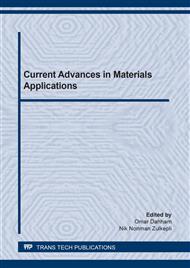p.33
p.47
p.57
p.66
p.75
p.84
p.95
p.104
p.114
Mechanical Properties of Chemical Treated Jute Fiber Reinforced Polymer Composites
Abstract:
Using PMMA Polymer reinforced by Natural Fiber (N.F.) materials have established much consideration because of several advantages for example low cost, non-abrasive, lightweight, non-toxic and the properties of bio-degradable. many kinds of research have been done in the recent usage of the natural reinforcing material to the preparation of different types of composites. Chemically treated jute fiber can enhance the surface of the fiber, decrease the absorption technique, and improve the roughness surface.in this research, pre-chemical treated in different lengths of jute- fibers in PMMA polymer-composites has been considered. Also, the effect of chemical treatment on mechanical properties of jute, jute reinforcing composite has been conferred. The results showed that the tensile strength T.S. of the treated in benzoylate solutions (4 mm) length fiber had good indicate to better interlocking between composite contents.Flexural-Strength F.S. of the-alkaline. solution treated (12 mm) length of fiber was obtained-better-results by increasing (16.5 %) compared with (2 mm) fiber-length. The fracture of the samples has discussed the relationship between composite adhesion. Impact Strength I.S. of the alkaline-treated (8,12 mm) fiber- a length that is due to to.better mechanical - interlocking between composite materials. The 2 mm fiber – length was not suitable-PMMA/ Jute composite in these tested for treated and untreated chemicals
Info:
Periodical:
Pages:
75-83
Citation:
Online since:
July 2020
Authors:
Keywords:
Price:
Сopyright:
© 2020 Trans Tech Publications Ltd. All Rights Reserved
Share:
Citation:


